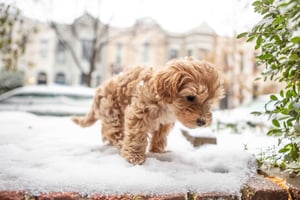Reverse sneezing is a common occurrence in dogs and can be very alarming for pet owners. It is a...
How to Stop Your Dog from Reverse Sneezing
Reverse sneezing is a common condition in dogs, but it can be quite alarming for pet owners. Fortunately, there are several ways to help stop your dog's reverse sneezing. This article discusses the causes of reverse sneezing and the various methods available to stop it.
What is Reverse Sneezing?
Reverse sneezing, also known as "pharyngeal gag reflex," is a condition in which a dog rapidly and repeatedly inhales and exhales through their nose. This can cause an audible honking or snorting noise, and can be quite alarming for pet owners. It is important to note that reverse sneezing is not a sign of illness or disease and is usually not serious.
Reverse sneezing is usually triggered by irritation or inflammation of the throat, nose, or sinus cavities. This irritation can be caused by allergies, foreign objects, or environmental irritants such as dust or smoke. It can also be triggered by excitement or exercise.
How to Stop Your Dog's Reverse Sneezing
If your dog is reverse sneezing, there are a few ways to help stop it. The first step is to try to identify the cause of the reverse sneezing and eliminate it if possible. If the cause is allergies, your vet can help you find an appropriate treatment.
If the cause is unknown, you can try to stop the reverse sneezing by gently massaging your dog's throat. You can also try to calm your dog by speaking softly and petting them. You can also try covering your dog's nose with your hand for a few seconds to interrupt the reverse sneezing.
If your dog's reverse sneezing persists, you should consult your vet as this could indicate a more serious underlying condition. Additionally, your vet may be able to recommend medications or other treatments to help stop your dog's reverse sneezing.
Preventing Reverse Sneezing
Once you have identified the cause of your dog's reverse sneezing, you can take steps to prevent it from happening again. If your dog has allergies, you should try to identify and avoid the allergens. You can also try to limit your dog's exposure to environmental irritants such as dust, smoke, and pollen.
If your dog's reverse sneezing is caused by excitement or exercise, you should try to reduce your dog's stress levels. You can do this by providing a quiet, comfortable environment for your dog and ensuring that they get plenty of exercise and mental stimulation.
Finally, you should make sure that your dog is up to date on their vaccinations and that their diet is balanced and nutritious. A healthy, balanced diet can help to reduce inflammation in the throat, nose, and sinus cavities and can help to prevent reverse sneezing.
Conclusion
Reverse sneezing can be a scary experience for pet owners, but it is usually not serious and can be easily treated. It is important to identify the cause of your dog's reverse sneezing and take steps to eliminate it. If your dog's reverse sneezing persists, you should consult your vet. Additionally, you can take steps to prevent reverse sneezing by avoiding allergens, reducing stress levels, and providing a balanced diet.



